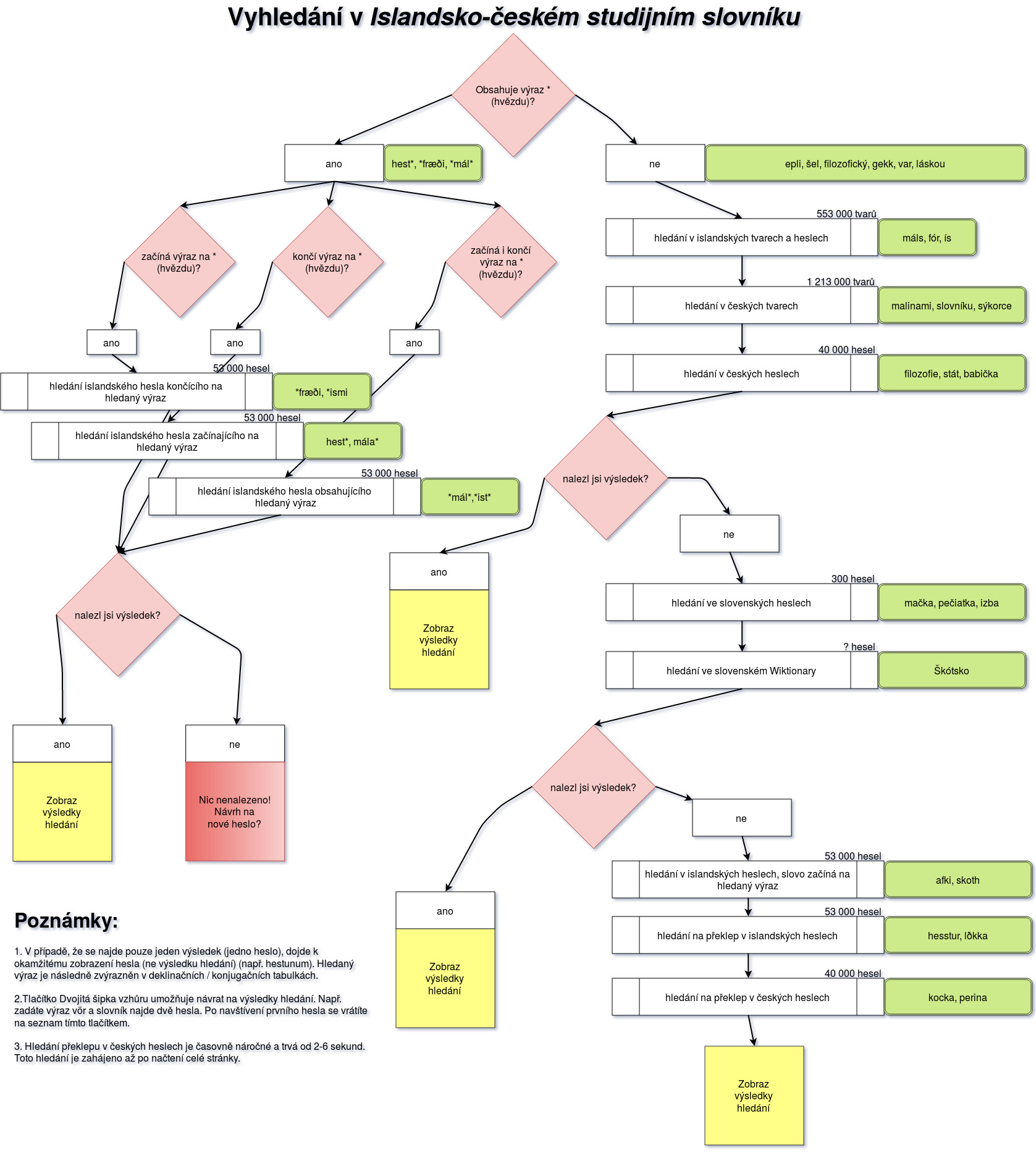The project of the Icelandic-Czech Students' Dictionary (ICSD) began in 2001 when a list of words was set up at the initiative of doc. PhDr. Helena Kadečková, CSc. of Charles University in Prague. The list contained Icelandic words and their translations; basic morphological information indicating the parts of speech and inflectional endings was added later according to the Concise Icelandic-English Dictionary (Hólmarsson, Sanders and Tucker 2007). At the time, the list contained around 1 200 words. It was published through a static website and later put on the website of Charles University.
In 2006 the Dictionary was extended by 1 500 new headwords and the existing headwords were extended by new meanings, especially by those of phrasal verbs. At the end of 2006, the Dictionary was transferred from the program Excel to the MySQL Database and the application Dictionary System (DS) (Chejn and Zaťko 2016) for supporting the creation of the ICSD started to be developed. The content of the Dictionary has been published under the free licence on the website www.hvalur.org (Chejn, Zaťko and J. Gíslason 2016).
In 2007 the first version of the application DS was developed. At the time, Renata Pešková Emilsson, who currently teaches Czech in Iceland, joined the project. She enriched the Dictionary by an extensive list of words related to everyday life in Iceland. The Dictionary was also extended by headwords from the Concise Icelandic-English Dictionary (Hólmarsson, Sanders and Tucker 2007). Over the next three years about 15 000 words were added. At the time, the headwords were extended by synonyms, examples, frequency and field and language categories. Kristýna Antonová, a student of Icelandic at the University of Iceland, joined the project for a short time. She drew attention to problems in the user interface of the application DS.
In the summer of 2009, a script for generating headword declensions and conjugations was created. The results were compared with Beygingarlýsing íslensks nútímamáls (Bjarnadóttir 2016) and consulted over the years with Jón Gíslason. Kristín Bjarnadóttir, the supervisor of the project Beygingarlýsing íslensks nútímamáls, responded to our many questions concerning declensions and conjugations.
In 2009 we started to collaborate with Ondřej Zicha and his project Biolib.cz (Zicha 2016). He provided us with a database of images, authors, licences and Latin names of botanical and zoological species.
In the autumn term 2009, together with Amir Mulamuhic, a Bosnian student of Icelandic at the University of Iceland, we applied for a grant of the Students' Fund of the University of Iceland to create the Icelandic Word Sound Database. The application was accepted. We used the money to pay Jón Gíslason, a native speaker teaching the Icelandic language at the University of Iceland, for recording more than 22 000 Icelandic words in electronic form. Together with Dorota Nierychlewska-Chejn, we set up two lists of headwords (one for Jón and another for processing his recordings). We created the Icelandic Word Sound Database (Chejn, Mulamuhic and J. Gíslason 2016) for supporting the recordings and the website was translated into six languages (Icelandic by Jón Gíslason, Slovak, French and English by Ján Zaťko, Serbo-Croatian by Amir Mulamuhic and Polish by Dorota Nierychlewska-Chejn).
In 2010 the rules of Icelandic pronunciation published in Handbók um íslenskan framburð (Pind, Magnússon and Briem 1991) were added to the Database. According to those rules we automatically generated phonetic transcriptions of all the headwords in the Dictionary. Jón Gíslason revised all the phonetic transcriptions.
At the end of 2011, we merged the website of the Dictionary with that of the application DS and we unified and improved the design of the new website. RNDr. Ingrid Nagyová, PhD., a lecturer at the University of Ostrava, assisted in creating the application DS with her valuable comments and suggestions. Ján Zaťko translated the new website and the Guide to the Dictionary into Slovak, French and English and the manual of the application DS into English. Dorota Nierychlewska-Chejn translated the website into Polish, Jón Gíslason into Icelandic and Marcos Helena into Portuguese.
From December 2011 to March 2014 we made the first revision of the Dictionary when we added missing information and new headwords and we corrected spelling mistakes. The content of the Dictionary was mainly compared with Íslensk orðabók (M. Árnason 2005) and Islandsko-český slovník (Kupča 2008). We consulted many translation problems with Vojtěch Kupča.
Between 2013 and 2015 the Morphological Guide was created. It extends the classic system of indicating morphological information in Icelandic dictionaries by a precise classification of headwords into specific inflectional groups whose paradigms are demonstrated on examples. In 2014 we received a one-year grant from the University of Ostrava to create the Morphological Guide. Doc. PhDr. Diana Svobodová, Ph.D. and Ing. Zuzana Havrlantová helped us to receive the grant.
From March 2014 to August 2015 we made the second and final revision of the Dictionary when we compared the information with the online dictionary ISLEX (Úlfarsdóttir 2016). Þórdís Úlfarsdóttir, the supervisor of the project ISLEX, provided us with a list of adverbial phrases. The list helped us to revise the Dictionary. We consulted various grammatical phenomena and matters related to inflection with Þórdís. Martina Kašparová, a student of Icelandic at the University of Iceland, revised the Dictionary focusing mostly on stylistic and orthographic aspects of the translations. Lucie Brabcová revised the Dictionary from a linguistic and typographical point of view.
In 2014 Vojtěch Kupča published Islandská gramatika (Kupča 2014) and he agreed to append an updated version of the publication to the book version of the ICSD. In 2015 Paolo al-Imkānī Brasolin helped us to typeset the Dictionary in the typesetting system LATEX. In February 2016 the Dictionary was printed in the printing-house MELMEN in Pardubice and bound in the bookbindery Vojtíšková Hrubá in Pardubice.
